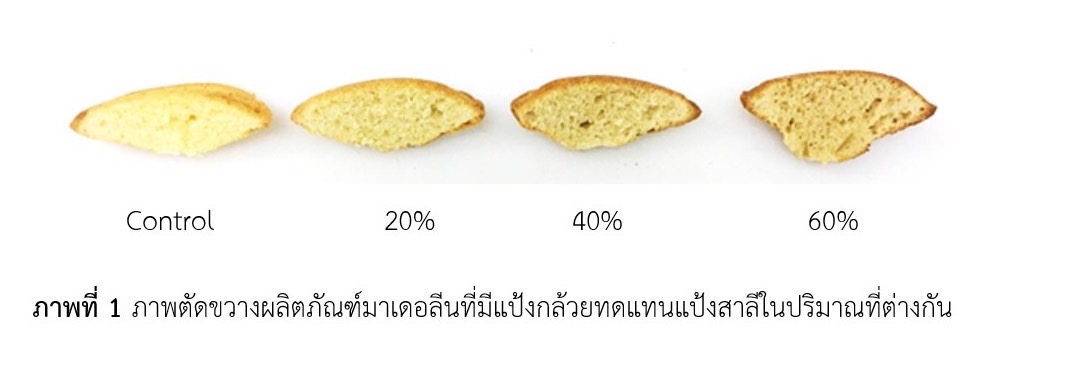The effect of banana soaking solutions on shelf life of banana flour and application in madeleine products
Main Article Content
Abstract
The study aims to study three banana soaking solutions: water, salt and sodium metabisulfide solution to reduce browning during banana flour production and monitor the change of color and moisture of banana flour after 10 weeks of storage. It found that the sodium metabisulfide solution was the most effective in reducing browning with the highest lightness (L*) value at 90.04±0.06. After 10 weeks of banana flour storage, the result indicated that storing banana flour in a laminated bag can slow down the deterioration of flour for more than 10 weeks. Then, banana flour after soaking in sodium metabisulfide solution was substituted for wheat flour in madeleine formulation which a type of bakery by 0% (control formula), 20%, 40% and 60% of banana flour. The results of sensory evaluation with parameters of color, odor, taste texture and overall acceptability showed that the panelists accepted the madeleine containing 40% of banana flour substitutes for wheat flour because the texture was close to the controlled sample as well as it still had the most banana aroma.
Article Details
References
จารุวรรณ บางแวก. (2559, 12 กุมภาพันธ์). โครงการวิจัยวิจัยพัฒนาและการใช้ประโยชน์จากแป้งพืชศักยภาพ. https://www.doa.go.th/research/ attachment.php?aid=2231
ชลธิรา บุญเรืองยา. (2545). การศึกษาอายุการเก็บรักษาแป้งกล้วย. [วิทยานิพนธ์ปริญญาโท]. สถาบันเทคโนโลยีพระจอมเกล้าเจ้าคุณทหารลาดกระบัง.
ณัฐฐพร สุบรรณมณี. (2563). ผลของการแช่กล้วยน้ำว้าในสารละลายชนิดต่าง ๆ และการประยุกต์ใช้ในผลิตภัณฑ์มาเดอร์ลีน.วารสารเทคโนโลยีการอาหาร มหาวิทยาลัยสยาม, 15(2), 110-121.
นิธิยา รัตนาปนนท์. (2557). เคมีอาหาร (ครั้งที่พิมพ์ 5). โอเดียนสโตร์.
นิธิยา รัตนปนนท์ และดนัย บุณยเกียรติ. (2548). การปฏิบัติหลังการเก็บเกี่ยวผักและผลไม้ (ครั้งที่พิมพ์ 5). โอเดียนสโตร์.
สมฤดี ไทพาณิชย์ และปราณี อ่านเปรื่อง. (2556). การป้องกันการเกิดสีน้ำตาลของผลิตภัณฑ์เนื้อกล้วยหอมตีป่นพาสเจอไรซ์. วารสารเทคโนโลยีการอาหาร มหาวิทยาลัยสยาม. 9(1), 39-51.
อัจฉรา เพ็งภู่ และขวัญดาว แจ่มแจ้ง. (2559, 22 ธันวาคม). การผลิตแป้งกล้วยต้านอนุมูลอิสระจากกล้วย 4 ชนิด.[เอกสารนำเสนอ]. การประชุมวิชาการระดับชาติ มหาวิทยาลัยราชภัฏกำแพงเพชร ครั้งที่ 3, กำแพงเพชร, ประเทศไทย
Mircea,E.D. (1995). Fruits and vegetable processing. International book.
Nimi, B., Pranati D., Mridula S. B., Dibya K.S., and Pranab D. (2018). Storage Studies on Spray Dried Ripe Banana Powder Produced by Response Surface Methodology. International Journal of Current Microbilogy and Applied Sciences. 7(6),1922-1933.
Praornpit Katchwattana. (2562). เกษตรอินทรีย์ ความหวังของผู้ประกอบการเกษตรทั่วโลก. https://www.salika.co/2018/06/06/organic-agriculture-sme-startup/.
Schwartz, S. J., von Elbe, J. H. and Giusti, M. M. (2008). Fennema’s Food Chemistry, CRC Press.
Singham P., Genitha L. and Kumar R. (2014). Comparative Study of Ripe and Unripe Banana Flour during Storage. Journal of Food Processing & Technology. 5(11),1-6.
Thipayarat A. (2007). Quality and physiochemical peoperties of banana paste under vacuum dehydration. International Journal of Food Engineering. 3 (4)


